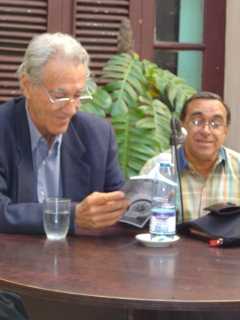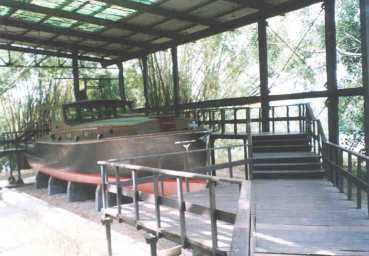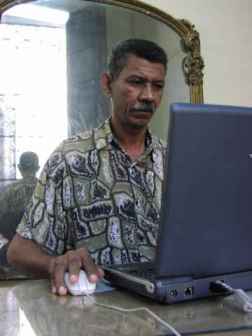 The historical and literary essay "Ernest Hemingway and the Romano Archipelago", awarded by Casa de las Americas with a mention in 1999, now is part of the wide oeuvre of Nuevitas-born writer Enrique Cirules. One hundred and twenty pages of interesting reading recently published by Ácana publishing house in Camagüey.
The historical and literary essay "Ernest Hemingway and the Romano Archipelago", awarded by Casa de las Americas with a mention in 1999, now is part of the wide oeuvre of Nuevitas-born writer Enrique Cirules. One hundred and twenty pages of interesting reading recently published by Ácana publishing house in Camagüey.
In this book, Cirules tackles a group of unknown aspects that had not been studied till today, and bear a very close relation with the life and work of Ernest Hemingway in Cuba for more than three decades.
For a long time, the author of "A Caribbean Mob Story: The Mafia in Havana" has studied the iceberg of Hemingway's presence in the largest island of the Caribbean; his adventures and experiences in the far and paradisiacal archipelago of Romano, located in the northern coast of Camagüey, setting of his last novel, published in 1970 by Scribnr's in New York.
Cirules shows how Hemingway became interested in the fabulous Havana of 1929, when he stopped over in the Cuban capital for almost two months in his second visit to the island. By those days, Hemingway met one of the most splendid and unpredictable women of that time, with whom he held an intense and shocking love affair.
That adventure helped Hemingway to shape some female characters for "The Short Happy Life of Francis Macomber", and for the novel "To Have or Have not", published in 1937.
 Cirules' book also reveals that the myth Hemingway in Cuba did not start when the author of "A Farewell To Arms" began to frequent streets, plazas, bars, taverns and restaurants, hotels and piers of the Cuban capital; but when he began to explore the mythical islands of Romano in 1930.
Cirules' book also reveals that the myth Hemingway in Cuba did not start when the author of "A Farewell To Arms" began to frequent streets, plazas, bars, taverns and restaurants, hotels and piers of the Cuban capital; but when he began to explore the mythical islands of Romano in 1930.
He made his first explorations in the boat Anita accompanied by his buddy smuggler Joe Rusell, owner of Slopy Joe in Key West. Afterwards, he sailed in a two-spar schooner owned by a rich family in Havana, and later on in 1934 he began to navigate in the yacht Pilar.
These continuous sailings -unknown sailings until today- toward the small islands of Romano in the 1930's, let Hemingway to get familiar with the vast coastal area that was virgin at that time.
Those were places that Hemingway began to visit repeatedly. They were charming sites with thousands of flamingos and big sandy dunes in the slopes, full of coconut trees and seagrapes.
The young man from Oak Park, Illinois used to sail away from the coves and the seagrapes of Romano to enter the spacious bay of Nuevitas and dropped anchor in El Guincho jetty and booked in one of the accommodations by the sea.
Those were buildings made of hardwood with balconies and terraces and waxed floor and their rooms facing the sea, to leeward of the famous Agustín el Tuerto's tavern.
In that place, the adventurers drank and ate all kind of seafood delicatessens, before taking the early train towards Camagüey, a city marked by old Roman Catholic churches, convents and plazas, where the streets are crooked and of paving stone.
It was common then that Hemingway and his friends walked all over the city, once known as Santa Maria del Puerto del Principe, and gazed at its colonial houses characterized by dissimilar indoor colonnades, eaves of French tiles and huge 'tinajones'[1] in the shade of the cozy flowery patios.
Afterwards they returned to Nuevitas, to El Guincho jetty, to the hoary wooden piers, to the streets made of stone that began on the slope. They returned to walk along the coast of colonial warehouses, built with rocks brought from the coral reef. The famous American writer could go sightseeing the green landscape of that hill, and knew the two tower yellow church built by a Catalan mason.
It was there that Hemingway got in touch with one of the most fascinating places of the Caribbean.
When the World War II begins, the author of "For Whom the Bell Tolls" and a group of friends started one of the most incredible adventures that any writer had done in the 20th century, that is to chase German submarines on a pleasure boat off the cliff of Romano keys for almost two years 1942-1943.
In his research, Enrique Cirules, author of "El iceberg de Ernest Hemingway en la cayería de Romano"[2], winner of a mention in Casa de las Americas contest 1999, has reconstructed the aspects that inspired Hemingway to write "Islands in the Stream", which is a fascinating pursuit of a group of Nazi submarines though keys, islands, streams and shallow waters of the central region of Cuba.
In these stories, Cirules tells us about the warfare actions in the Bahamas stream, the Cuban writer reveals the existence of a third German submarine that got sunk in the waters of this hemisphere during the World War II, this event, though ignored by specialists, still remains in the historical memory of the dwellers here.
The combat against this submarine, three miles north off the Maternillos lighthouse inspired Hemingway to write the last part of his wonderful novel. All these new elements confirm that Cirules' book is one of the most revealing texts published over the latest years about the work and life of the most universal US novelist of the 20th century.
Aside from these aspects, that were never treated nor studied before, "El iceberg de Ernest Hemingway... " reveals the myths and legends that surrounded the village of Versalles, a coastal city founded at the end of the 19th century by French immigrants, in the easternmost area of Romano key, a place that Hemingway knew very well. In the book Cirules mentions the fishermen of the region that wanted to sell the novelist an old pirate map and tried to persuade him to go for lost treasures.
Essential aspects of these stories were retaken by Ernest Hemingway to write "Islands in the Stream", the most autobiographical book of his lifetime career as a novelist.
Enrique Cirules was born and grew up in those places, and before becoming a famous writer he met the mythical characters that once held continuous relationships with Hemingway in the 1930´s and after.
Hemingway seen by fishermen and bartenders
It is for that reason that Cirules' book portraits the vision that the fishermen, the turtle hunters, the immigrants, the rogues, the sailors and above all the bartenders of the El Guincho, Nuevitas had about Hemingway, with whom they were in touch for many years.
Agustín el Tuerto's famous tavern, frequently visited by Hemingway, is described in Cirules' book. The essayist depicts the strange and fascinating accommodation that stretched its balconies towards the sea, a place run by a woman nicknamed La Colombiana, the splendorous Gato Negro, the most exquisite restaurant by the surroundings and the lights of the Hotel Filgueras, a spot where captains and sailors, gamblers and adventurers did their parties.
The mystery and magnetism of two settlements founded by Americans and Germans at the beginning of the 20th century in the northernmost part of the Camagüeyan savannah are also described in "Ernest Hemingway and the Romano Archipelago". By those days Hemingway carried out his submarine hunting in an archipelago featuring the largest game and fishing preserve in the Caribbean, swarming with wild dogs and horses, deer, flamingos, herons and above all ferocious sharks.
These new elements, present in the life and work of the great US writer, revealed in "The iceberg of Ernest Hemingway in the offshore islands of Romano" are the widest contribution to the narrative universe that Hemingway treated in the most splendid of his novels: Island in the Stream, a novel he wrote in 1947, but did not give to his editors.
A book about the World War II which was published, revised corrected and maybe bowdlerized ten years after his death.
Notas de referencias
- Tinajón: A huge, coarse and belly container made of earthenware, resembling a jar that is commonly used for water storage in a city where the liquid is not abundant. The city of Camagüey is known as the city of the tinajones.
- "El iceberg de Ernest Hemingway en la cayería de Romano": Cirules, Enrique. "Ernest Hemingway and the Romano Archipelago". Ediciones UNION, 1999 (Translated from the original Spanish).
 Lázaro David Najarro Pujol, escritor y periodista.
Lázaro David Najarro Pujol, escritor y periodista.
Labora en la emisora Radio Cadena Agramonte de Camagüey.
Autor de los libros Emboscada y Tiro de Gracia,
ambos publicados por la Editorial Ácana de Camagüey.
Editor del Sitio Web: http://camaguebax.awardspace.com/




![]() Cuba. Una identità in movimento
Cuba. Una identità in movimento![]()